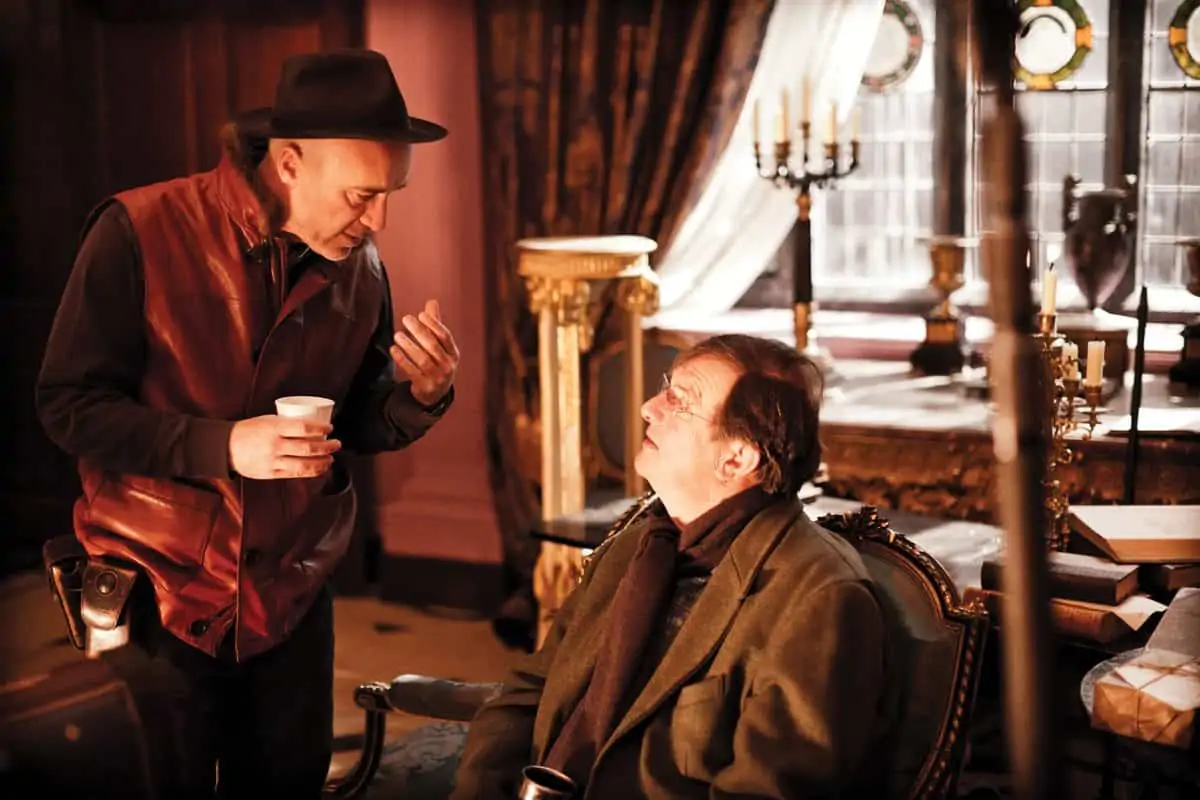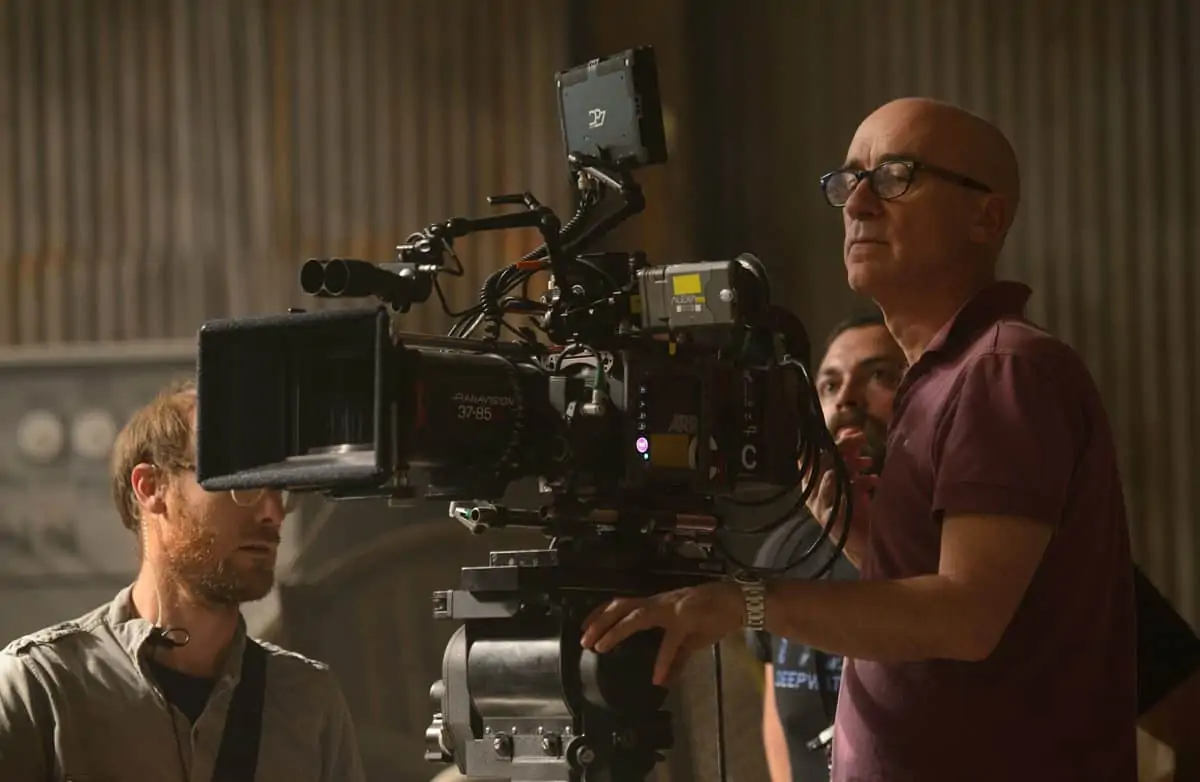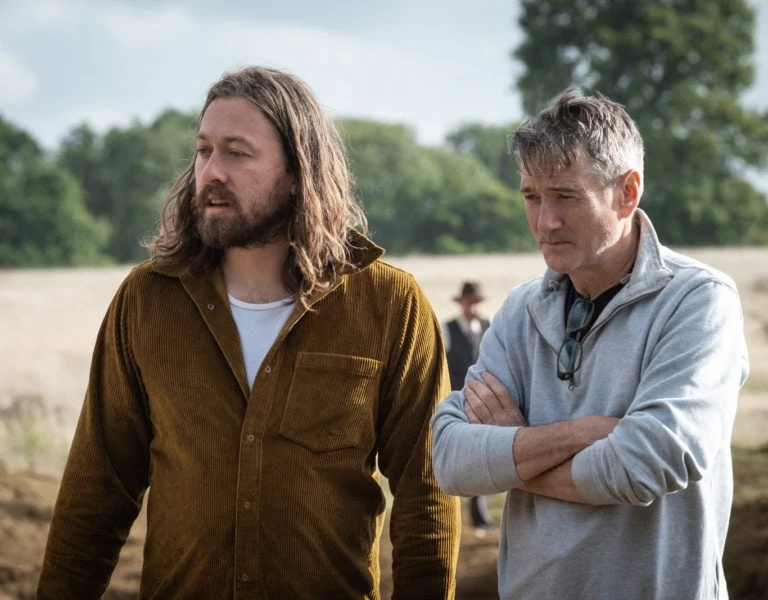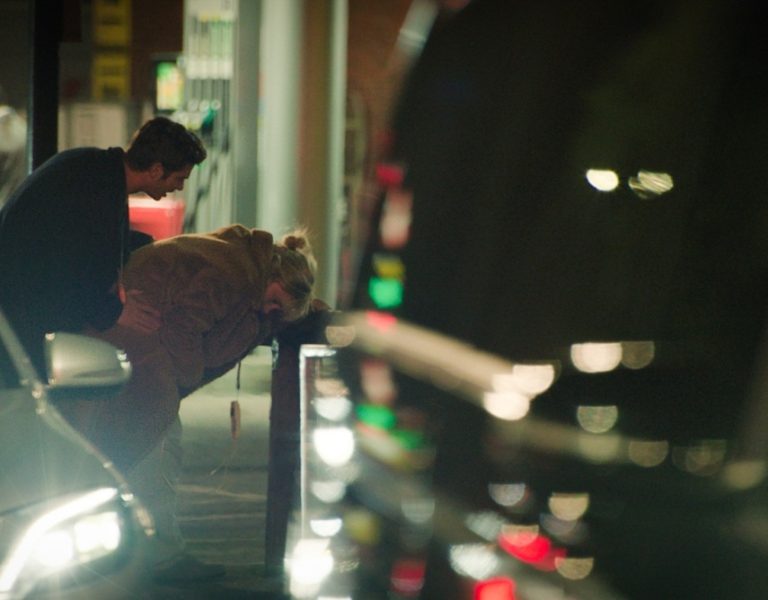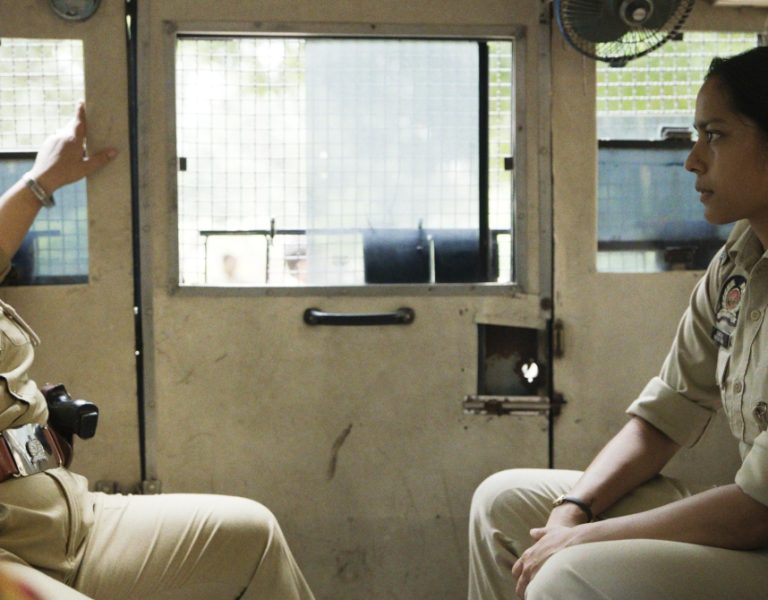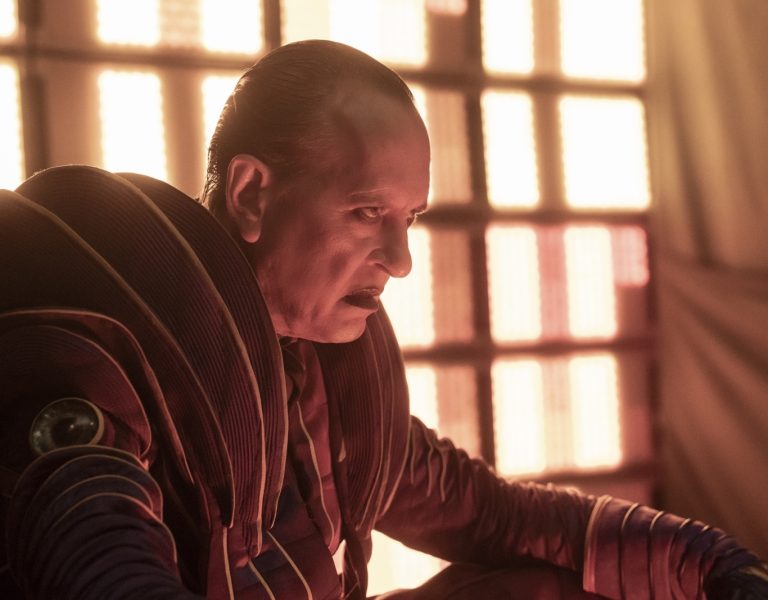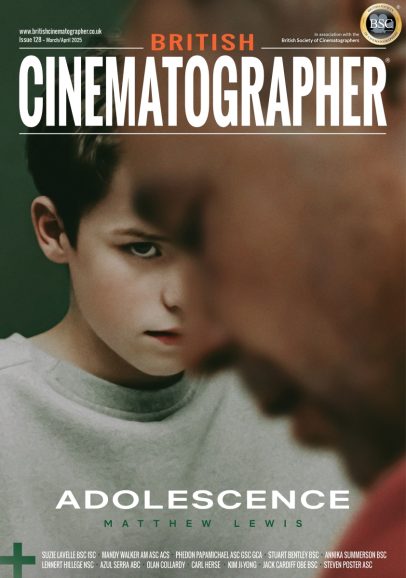THE EMPIRE STRIKES BACK
A unique energy was created on set when shooting Gladiator II as breathtaking battles in ginormous sets were captured by multiple cameras. With treasured memories of making the original Gladiator with Ridley Scott still fresh in his mind, John Mathieson BSC discusses the next stages in the thrilling journey with the director as they made an epic return to the Roman Empire.
It’s been 25 years since director Ridley Scott, cinematographer John Mathieson BSC, and an army of valiant cast and crew joined forces to make historical epic Gladiator. Fuelled with new ideas and a passion to continue pushing boundaries, the pair entered the arena once again to explore the next chapter in the story, combining gripping battle sequences, vast sets, multi-camera shooting, and advanced visual effects on screen.
Although this marks Mathieson’s seventh collaboration with Scott, the cinematographer admits he did not see the sequel to Gladiator coming. “There’s been talk of this film for a while, but it’s always dissolved into thin air because how do you make it when some key characters died in the first film?” he says.
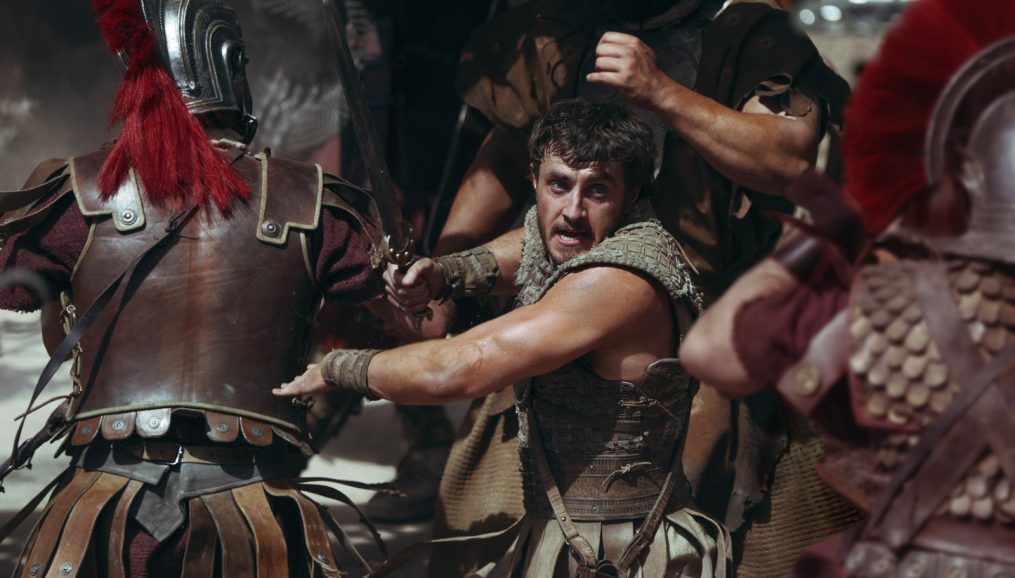
The popularity of Gladiator just kept growing, highlights Scott: “The film stayed in the public’s mind. I knew we should consider a sequel, but it took years to figure out what the story was going to be.”
The sequel picks up 15 years after the death of Maximus Decimus Meridius, Russell Crowe’s character in the original. Combat in the Colosseum is more deadly, and The Roman Empire continues its march across the world. Screenwriter David Scarpa began by placing the main character, Lucius (Paul Mescal), in a situation opposed to Maximus’ story. Where Maximus started as a leader in the Roman military who is facing off with an army of barbarians, Lucius is a barbarian defending his home from the invading Romans.
Prep was rapid for a film of such epic scale, with Scott producing beautiful storyboards during the six-week pre-production, giving the crew a feel for the world he wanted to create. “Ridley’s drawings are the bible – you pore over them with him on his campaign table in the morning,” says Mathieson.
Scott is adaptable so if a sequence is not right, he will do something else. “Of course, you must lock to specific aspects such as shooting a stunt or a VFX shot, but as you come out of that moment, he is able to change.”
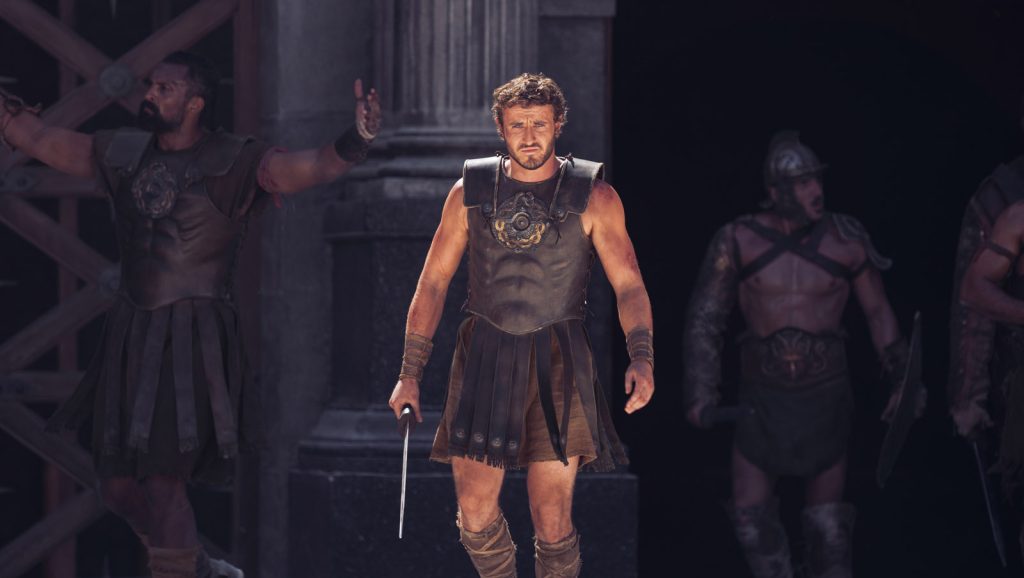
An image-driven world
Mathieson considers Scott to “be a part of all of us” and a filmmaker who has introduced worlds to audiences they did not know existed. The director has been “scaring the hell out of” the cinematographer since he watched his terrifying creation, Alien, aged 16. “You know when you’re watching one of his films and it was great to be asked to work with him all those years ago as I loved his work. I still admire them, even when I’m on his films,” says Mathieson.
Working with a director who “talks a language of images” makes each story realised. Being a talented draftsman, Scott creates images in prep as if they have been shot through a 100mm lens “whereas many storyboard artists draw in the way an iPhone sees the world,” adds Mathieson. “He lives in an image-driven world and gives you depth, so you know exactly where to go with the camera. It’s instinctive.”
Kit and technology have evolved since the pair collaborated on Gladiator, processes are faster and Scott enjoys digital capture because of its clarity of image, and ability to run many cameras and see them instantly and simultaneously on high-grade monitors. “Our sets were also huge, a quarter of a mile long, so having everything piped back to one command centre is much better for him. Some walls were 60 foot high, and the action might unfold high up on a ship on wheels, so the distances are enormous,” adds Mathieson.
“If Gladiator had a lot of visual effects, I’m not sure it would have been as iconic. It’s a film everyone knows but there were only 50 VFX shots – they were real sets, tigers, lions, balls of fire and arrows – and that has stood the test of time,” says Mathieson. “25 years on, you can do a lot more with VFX, and Ridley has embraced that.”
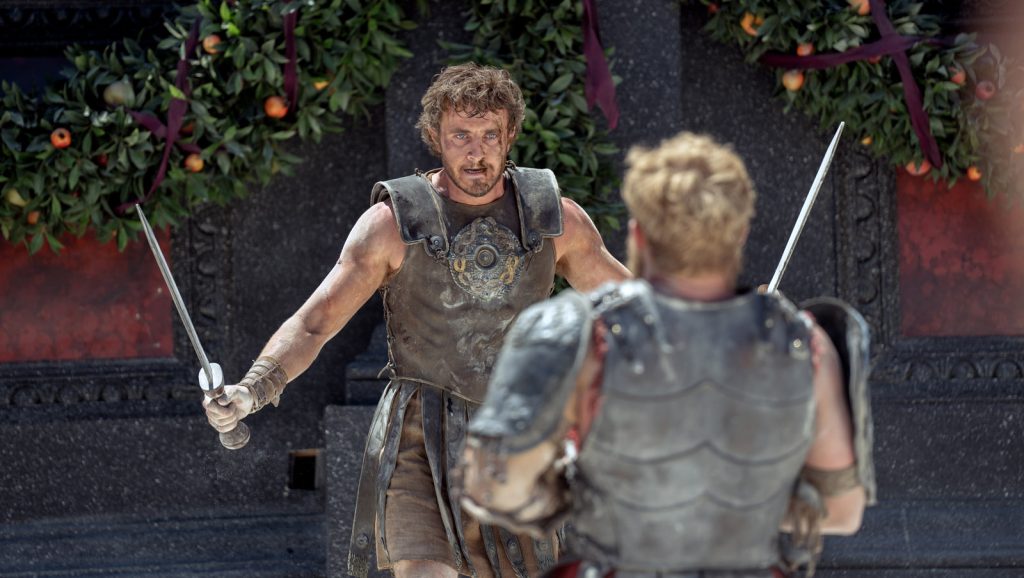
Despite being more VFX and CGI heavy than the first film, the filmmakers take pride in the amount that was achieved practically. As Mathieson highlights, “compared to many other current productions of this scale, Gladiator II is still a real film with real sets and real people”.
As in Gladiator, the Colosseum was built to scale in Malta, complete with the arena, the palaces, the senate, and the forum of ancient Rome, and then “topped up in post”. This realistic setting helped actors as they felt they were walking into Rome. “When Paul (Mescal) stepped into that arena everyone roared. That was a real experience for him which Russell (Crowe) probably also shared in the original,” says Mathieson.
“If they walked out into a green screen ring it wouldn’t be the same. It was great for the crew too. People who have made movies for years walked around that set with their mouths open. I don’t know if we’re going to see something quite like this again.”
Denzel Washington, who plays Macrinus, considers Gladiator II the biggest film he has worked on. “Everywhere you turn on this film, you’re in that world,” he says. “Being on set with thousands of soldiers in beautiful costumes and brilliant colours and swords and shields and horses made this seem like more than a movie for me. It’s a world unto itself.”
One creature-focused sequence in the sequel features a rhinoceros battle – something Scott wanted to include in the original but it was too expensive to achieve with CGI. Bringing this to the screen 25 years later was a joint effort between Neil Corbould, special effects supervisor, Industrial Light & Magic (ILM), and prosthetics designer Conor O’Sullivan. “We made a mechanical rhinoceros that could shake its head, flick its nose up in the air, and move its eyes and ears,” says Corbould. That was enhanced with visual effects, so it could be driven around the Colosseum “like a go-kart”. “The camera operators could actually shoot a rhino, not a wheel barrow and bunch of green tennis balls,” adds Mathieson.

The vicious baboons that explode onto the screen in a brawl with the captured Numidian prisoners in the local arena, were in fact smaller stunt performers with short crutches, dressed in black with masks. “They could fight the Numidians. We photographed the actors swinging at and connecting with the stunt team rather than swinging into mid-air,” says Mathieson. “ILM VFX supervisor Mark Bakowski and the visual effects teams then had to remove the stunt people, build entire CG creatures, and rebuild parts of whoever they’re fighting if the stunt baboon covered more of the actor than they should.”
Blending practically shot elements and visual effects seamlessly was integral when creating an epic on screen spectacle, aided by a more sophisticated level of VFX tools than Corbould and his team had access to when working on Gladiator. A scene in which the Colosseum is flooded with water and man-eating sharks is a shining example of practical shooting and VFX working in harmony. “There were two obvious ways we could approach it,” highlights Corbould. “Build the Colosseum in a tank or use visual effects. The best solution was to do both.”
Many of the larger shots were filmed dry in the Colosseum, with Bakowski and his team of digital artists adding water in post-production. Production designer Arthur Max (Gladiator, The Martian, Napoleon) and his team also built a full scale section of the Colosseum in the huge water tank nearby for the interactive surface shots and a few underwater scenes.
“I knew when we shot it dry, as long as we kept our cameras under the waterline, we wouldn’t be in the VFX team’s shots,” says Mathieson. “The boats were then floated in the water-filled tank to complete the scene which looks fantastic when combined with VFX. For sequences like that, from a camera perspective, we must catch the spectacle of it but not dominate the action or how the day goes. That is driven by Ridley, SFX, stunts, and what VFX need.”
The ambitious opening sequence depicting the siege of Numidia as the Roman navy closes in was shot mainly in Ouarzazate, Morocco, at the former Kingdom of Heaven set (directed by Scott and lensed by Mathieson) which production designer Max restyled and extended. As the location is in the middle of a desert the sequence – starring two 120-foot, 80 tonne ships – needed to be shot dry. The boats were placed on SPMTs – enormous all-wheel-drive, remote-controlled, industrial hydraulic machines capable of holding the giant structures and moving them in any way desired – allowing the ships to be steered over the graded desert sand to attack Numidia by sea, with CGI magic transporting those scenes into a vast sea.
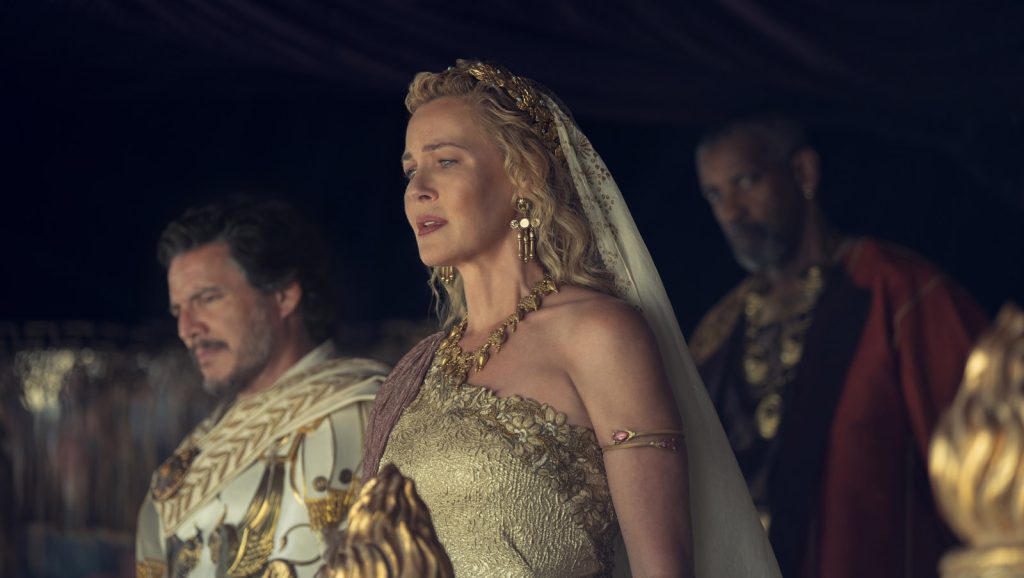
Recreating Rome
Whereas films set in fantasy locations have fewer restrictions as they are unfamiliar to the audience, Gladiator II is set in Rome – a real place the audience knows and where the Colosseum still stands. “The atmosphere, the aesthetic had to be correct, so what better way to make it look good than to actually build it?” says Mathieson.
Everything was much bigger and more elaborate than anything production designer Max, who worked with Scott on 15 previous projects, had experienced. “It’s Gladiator on steroids,” says Max. “Ridley’s approach to making a film is always immersive. He’s involved in every phase, every department.”
Many of Rome’s impressive historical settings were recreated in an area approximately six square
kilometres. To shoot some of the spectacular scenes taking place in and around the Colosseum amphitheatre, the production returned to Fort Ricasoli in Malta, the 17th-century building that served as the site of the Colosseum set in Gladiator.
Max’s team built around 60 percent of the structure from the foundation up to enable Scott to stage ambitious action sequences, with the set built to 46 feet high and digitally extended in post. “We knew we had to fill it with water. So we raised the foundation up about five feet so we could still see what we wanted above the water line when we flooded it digitally,” says Max.
The black-and-white Styx scene was shot in a warehouse in Malta, with a glassy sea of 2mm mirrorflex highly polished mirrored surface brought in along with black pebbles sprayed silver to create a shoreline and skies. “They were beautiful, twisting, gentle tornadoes pulling out of this grey sky on a grim grey horizon which was added in post,” he says. “I love the way that scene looks – a mixture between Bill Brandt’s black-and-white coastal pictures in the ‘40s and ‘50s and Man Ray’s solarization images which Ridley provided as references.”
As well as Brandt’s famous 1957 ‘East Sussex Coast’ black-and-white photograph of a human ear sculpture in the foreground with pebbles, rugged cliffs and a dramatic sky behind, the films of Ingmar Bergman, also came up, in particular The Seventh Seal (1957), one of Scott’s favourites.
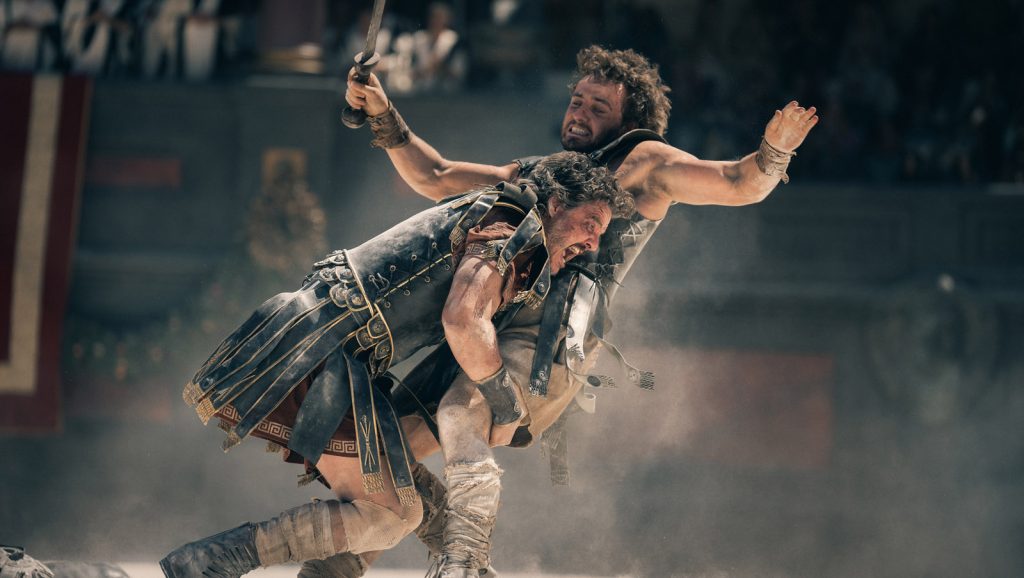
The essence of the scene
Scott, who is known for using up to four cameras at a time, regularly used eight to 12 on this occasion. Each scene is directed like a play, with simultaneous action taking place all over the set. “You have to know exactly where to place the cameras,” says Scott. “I can do that because I’ve storyboarded it all in advance.”
The same rules apply whether shooting an intimate scene or epic battle featuring extras in abundance, highlights Mathieson. “There are still wides and close-ups – it’s nothing to be daunted by. People ask how you make films of such epic scale. Just keep your head. There’s a lot going on around you, but you have the boards, get your eye to the viewfinder, listen to the comms, go into the world, and frame up what is needed.”
The secret to using multiple cameras as effective storytelling tools lies in logistics, timing, and communication, says the cinematographer: “Your first three or four cameras are really going to do the work and the others are for detailing, maybe trying to pick up a reverse, later action or a moving insert.”
Scott’s background in television, shooting BBC series such as Z-Cars early in his career, and Mathieson’s experience shooting rock ’n’ roll music videos with a live vision mixer and multi-camera set-up stood them in good stead. “All the cameras might point at Paul (Mescal), and only one or two may get a good shot, with the rest after something else,” says Mathieson. “Ridley is skilled at that because he cuts as he goes.”
Multi-camera shooting is helpful for actors – as performance continuity is not such an issue – and for editors who can seamlessly cut. Stunt coordinator Nikki Berwick also found it useful as it avoided repeating the same sequence from different camera angles and meaning they could “get a scene done in just a few takes”.
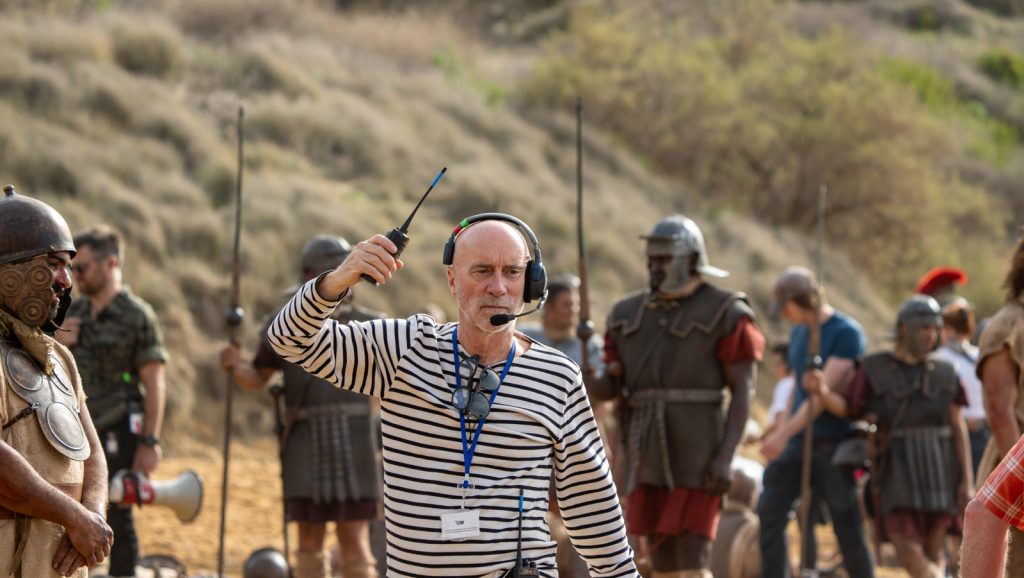
Detailed briefing of operators was vital as Mathieson then moves between them and Scott during the shoot, ensuring the vision is translated on screen and finessing is carried out. But he admits he does not enjoy some aspects of multi-camera shooting as “the light only looks really good from one or two angles, but I recognise multi-camera is the way to do it when It takes so long to get those sequences going, so many people have been up for hours, it’s 100 degrees and almost unbearable. So you better make sure you don’t muck people around by trying out different lenses.
“Put the zoom lenses on and we’ll get what we need. It might sound callous, but you’re under pressure. People are firing arrows on boats and it’s exciting and fast paced. Maybe it’s not possible to totally finesse at all times, but it’s got great energy to it and cuts really well because it’s all in continuity.”
Mathieson used camera crew he knows well and trusts to build and execute shots, including A camera/Steadicam operator Pete Cavaciuti ACO GBCT Assoc BSC. Sequences that were blocked and rehearsed often changed when shooting, meaning the A camera could easily become the F camera when the action turned, so each operator had to be on point at all times. Scott would discuss shots and the operators would present positions and platform requirements to the grip department who then had to work at speed, liaising with other members of the crew to create a successful and beautiful shot as quickly as possible.
“Ridley’s operators need to be self-confident, creative, self-reliant and show great initiative, as well as working together with the prop department, assistant directors had to get props and extras in the right place, the large grips department had to get the correct camera platform, be it crane, dolly, Steadicam or handheld in the right place and the mechanics of the shot rehearsed,” says Cavaciuti. “The scale of the project was unique, the physical size of the sets were the largest I have seen in my career, giving the operators an incredible scope of opportunity.”
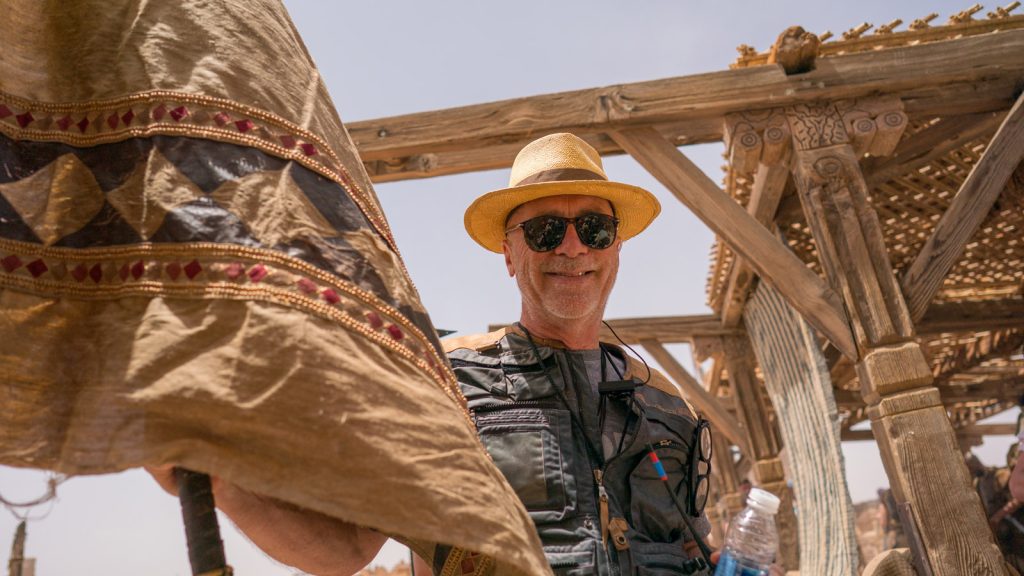
Cavaciuti’s personal favourite Steadicam shot is of Lucius as he exits a river full length after a gory fight. “The sun was setting and the sky became golden and I just saw a beautiful shot offering itself to me,” he says. “I let Paul (Mescal) start full length and then slowly gain on me, walking into a medium close-up, with hundreds of Roman soldiers directly him behind with shields and spears, beautifully backlit as the sun set, and then trading off onto Ravi and Darius on horseback over Lucius and then Lucius turning into medium close-up again as he walked towards the opposing Romans.”
Capturing the essence of the scene in rehearsals is important and something which Scott often wanted to shoot. “It’s very fast, and I’ve got great and incredibly quick ACs, headed up by 1st ACs Lewis Hume and Ryan Taggart, and an incredible key grip Dave Wells,” says Mathieson. “I’m sure they would like more time to finesse, but then what do you trade off? There’s a certain amount of energy you probably wouldn’t get if you fiddled around all day and the stunt performers would also go a bit flat.”
All eight camera teams included 1st, 2nd and 3rd ACs, and equipment included 10 camera bodies, around 60 lenses, scuba bags, HydroFlex, four trucks, and a lengthy line of carts – the largest equipment carnet ever to leave Panavision UK. Information and clear communication was more vital than ever, says 1st AC Hume: “Shot-by-shot instructions came to each camera team from the operators, who were all on radio listening to Ridley directing key members of the unit. The ACs ran two separate radio channels within the department to avoid airwave chaos.”
Cameras were “shuffled about like chess pieces across the set,” says Cavaciuti, with key shots not necessarily always allocated to A or B and operators often in costume to blend in with the background. “What gear and which cameras were running, standing down, or on the move created a constant flow of radio chatter. 25 ACs worked brilliantly as a team – the department was always ahead of the curve despite a challenging and unusual way of working. It was great fun and a very unique experience.”
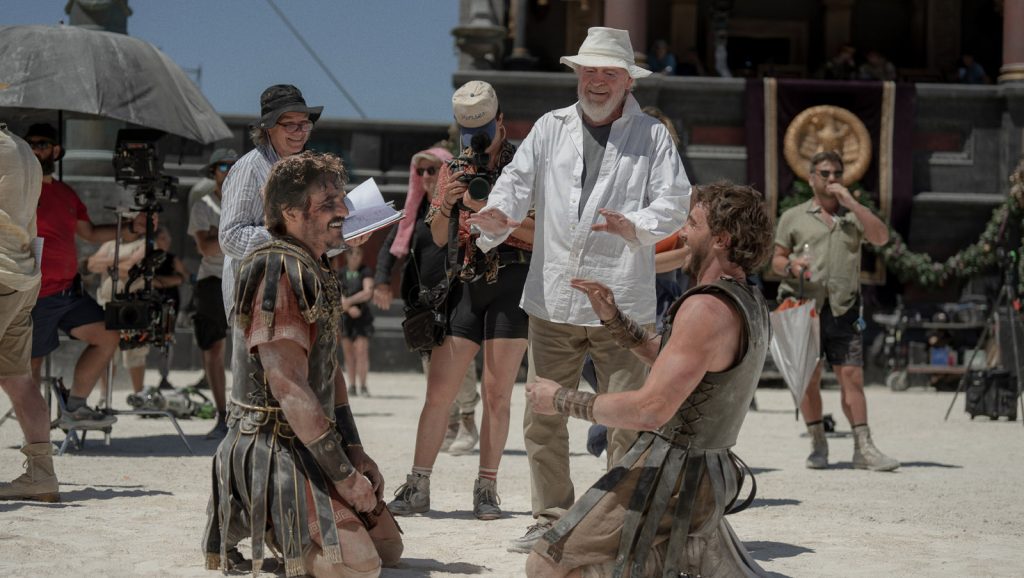
Capturing the action
Mathieson views operating as choreography, trying to work out how the action breaks down, capture it as quickly and efficiently as possible, and predict how far you can go in the scene in that position. “It’s also about which bits to forget and give to someone else. Don’t worry, your camera might run for a while, but the action will tumble towards you, and they will be coming straight at you,” he adds. “Not every frame is on all the time, but between you, you’ve managed to keep the scene moving which is what Ridley is after.”
Working with a “superb” VFX team offered freedom to the operators who were often in each other’s shots. “We had a very cooperative team of operators who worked so happily with each other. I’ve known Chris Plevin ACO Assoc BSC on B camera since we started in the business and all the operators knew we could rely on each other to fine tune things,” says Cavaciuti. “We had excellent communication between us and a non-ego driven department which would move positions if required so as not to harm another operator’s shot.”
A standardised camera package that saved time was essential, leading Mathieson to opt for ARRI Alexa Mini LFs, which Panavision had most of in stock. “The ARRI Mini LFs were also superb in the searing heat of the desert in Morocco and the equally hot and humid Malta,” adds Cavaciuti.
Zoom lenses needed to be powerful as Scott likes sharp images. Supplied by Panavision, these included 28-80mm and 70-185mm Panavision Primo 70 Zooms, 22-60mm EZ-2 and 45-135mm EZ-1 Angénieux zooms, and 36-435mm Angénieux Optimo Ultra 12-Xs. “We had multiples and also shot with the Optica Elite which I love. It’s 120-520mm which you can double up to 240 -1140mm. That’s a massive lens, and also very fast.”
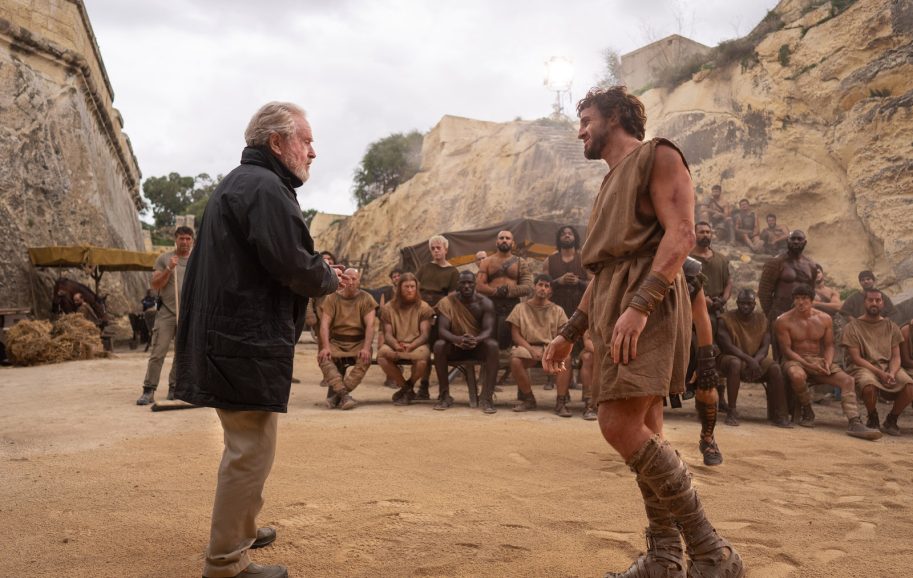
Two sets of Panavision T1.4 Panaspeed primes were added into the mix, “but rarely came out as it’s all about the zooms with Ridley, because you have to move onto another set-up quickly,” says Mathieson. “All the big, wide shots from various epic films normally use a zoom because you don’t have time to change primes, rebalance the head, remount the motors. We also wanted practical kit we could use quickly and easily so the talent wasn’t waiting for us.”
He shot in deep stops because “if you’re shooting a close-up of Lucius wide open on a 180 or 250mm lens, the background will turn to mush. You don’t want that, you want to retain the focus and feel the shapes of the Colosseum, the rows of people, the guards and horses.”
“Getting a move on” is a valuable lesson for any cinematographer, says Mathieson, who while not believing all films should be made that way, feels it is important to emphasise that time is money. “And this movie was a lot of money, so it’s crucial to be fast, be ready, and think about what you’re going to do next. Ridley probably works even faster these days than he used to. This shoot was listed as 49 days, we were 50+, so it was short for the size of film. Ridley wants to get going early, and finish on time or preferably before time.”
A heavy grip crew headed up by Dave Wells kept the crew ahead of the game, ready to capture any action encountered using kit such as a fast-moving 45ft Scorpio on a Panavision Viper and 75ft Super Technocrane with an automated base; GFM GF8 modular crane, GFM Multi Jib, two Libra L7, a Libra L8 Scorpio EZ head, DJI Ronins, Silverado six-wheel tracking vehicle, an electric bike EXO Stealth Tracker ridden by precision rider Rob Herring, five Chapman Hybrid & PeeWee dollies; hundreds of feet of track; an abundance of rigging equipment and timber; and plenty of handheld skill from the camera operators. Two Steadicam kits were used, operated by Cavaciuti and Daniele Massaccesi AIC. With such a vast amount of camera and grip equipment the camera crew were never short of possibilities, aiding and enhancing the creative process.
In situations where Mini LFs were too large, Z Cams were used – small crash cams well suited to capturing scenes featuring carriages or boats smashing into each other. “They’re excellent – you stick on a lens and off you go. They’re also small enough they could even be wrapped up in hessian and hidden in shot,” says Mathieson.
Scott was keen to use moving cameras and document movement of characters through physical space to create a feeling of reality. “For example, in the scene where Lucius arrives in Rome, imprisoned in a cart, cameras were covering the arrival, hidden behind stone columns – two or three small hidden Z Cams in the cart itself, tracking cameras along the colonnades, a drone in the air, a crane swooping in, and a handheld camera as Lucius stepped off the cart,” says Cavaciuti.
Fast moving and relatively low aerial shots over Rome were captured by drones rather than helicopters, controlled by local crew in Malta and headed up by drone pilot Mario Demanuele with Warren Brimmer as drone operator. Sweeping shots of the vast city the team captured were also used by the visual effects team.
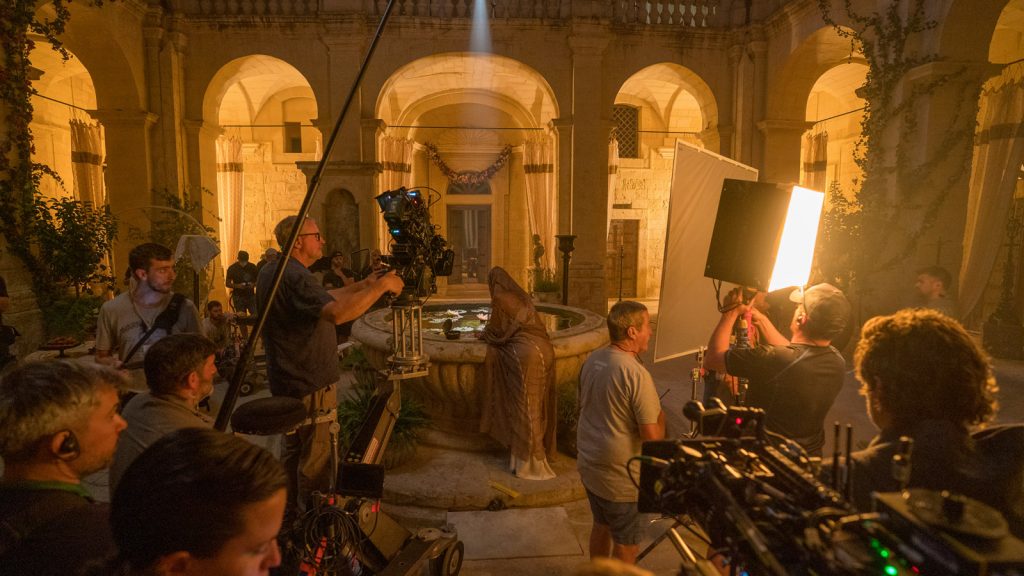
Making a splash
Second unit DP Katie Swain GBCT worked with a splinter unit to primarily film in and around the tank in Malta, next to Fort Ricasoli, where the Gladiator arena set is located. They shot several intense sequences mostly surface and some underwater. Scenes included those involving shark attacks, the Persian boat ramming the Athenian boat in the Colosseum, Romans taking arrow hits, and a dramatic burning sequence below decks that featured full burns with 10 members of the stunt team. Additional photography also included shooting horseback riders on a hillside (near Brighton), carriage work, and interior/exterior scenes at Shepperton Studios to match previously shot footage in Malta.
Gladiator II marked Swain’s third collaboration with Mathieson, meaning she was already familiar with his approach, especially lighting and lens choices. “I had worked with him as the D camera operator, so when it came time to shoot second unit under the direction of Luke Scott, I was well-tuned to his vision,” says Swain, who found working with Ben Borg Cardona, one of the main unit operators who became the underwater operator, a pleasure.
“We shot scenes involving the stunt team falling from a boat onto oars and jerk rigs, including shark grabs and blood explosions, as well as the dramatic boat collision in the Colosseum. Ben had to carefully navigate the underwater rig, which was designed to pull the boats together for the collision, while managing lines for the stunts and special effects waves. We also shot Lucius’s fall from the walls of Numidia into the sea, which added another layer of complexity to the underwater choreography.”
In addition to Borg Cardona shooting in the water, one camera on a 45ft Scorpio on a floating pontoon was operated by David Penfold, and two handheld cameras operated by Ciro Candida and Luis Gabriel “Gabo” Gordo Gavira. 1st AC, Elliot Purvis, and 2nd AC, Freddie Fitzherbert, along with grip Duncan Stevens coordinated the rest of the 2nd unit camera team to ensure everything ran smoothly.
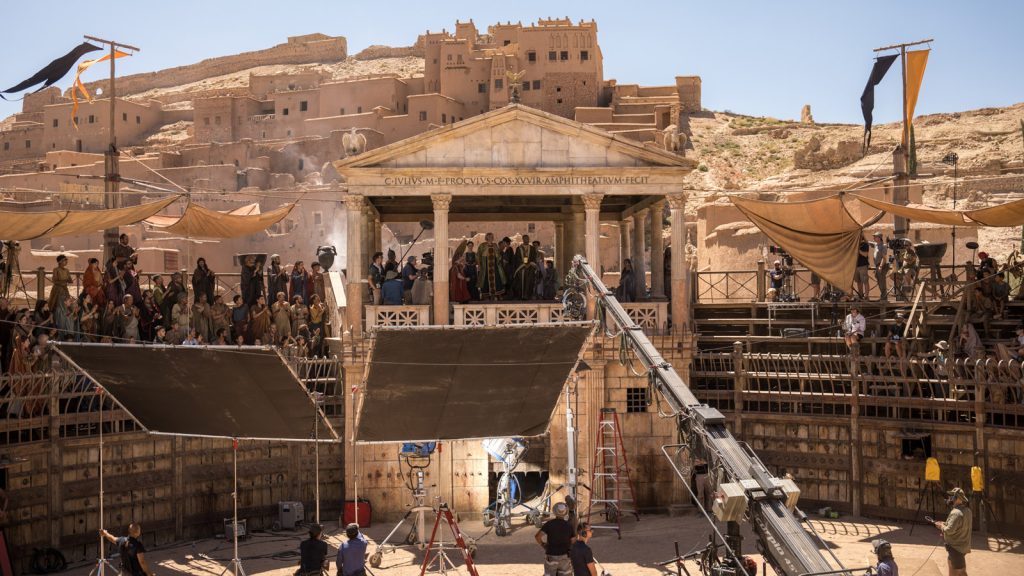
The camera package provided the 2nd unit the flexibility and precision needed, especially in the challenging underwater environment. They shot with Mini LFs, using zoom lenses already utilised by the main unit and Borg Cardona used Panaspeeds in underwater housing.
The burn sequences below decks in Malta were particularly challenging as the crew had to carefully place the cameras as close as possible to the flames to capture the intensity of the action, while not compromising the stunt team’s safety, who had limited visibility while burning. “After consulting with Neil Corbould, SFX supervisor, and the stunt team – and considering the wind direction for the smoke – we carefully chose our camera positions, including remote cameras placed in crash housings within the flames along the hull,” says Swain. “Additionally, matching the January weather for sequences shot in the Colosseum under the full summer sun was tricky. We had torrential rain one day and a lot of cloud cover, which made it challenging to maintain lighting continuity.”
Swain, who has been in the film industry since she was 18, started as a camera trainee at Ealing Film Studios before beginning her career as a DP in 1994, shooting music videos and commercials, before branching out into TV dramas and independent films. “Back then, as a woman, it was almost impossible to break into mainstream feature films – it was very much a man’s world,” she says. “After having my two children, I pivoted back into directing and shooting commercials, as spending long periods away from home wasn’t an option. So, the opportunity to finally transition into features, thanks to John Mathieson, has been incredibly rewarding. Working with John and Ridley Scott on this project made the long wait worthwhile.” Her next project is Masters of the Universe (2nd unit) with Fabian Wagner ASC BSC.
An enlightening experience
Gaffer Chuck Finch’s working relationship with Scott and Mathieson has evolved over multiple collaborations including Kingdom of Heaven back in 2005, the set of which was adapted for Gladiator II, meaning he was familiar with lighting environments of such epic proportion.
“The trouble when you have so many cameras is where do you put the lights?” says Mathieson. “On this occasion we had banks of 18Kw Arrimaxs on the edge of the Colosseum to help with edges in the late afternoon. Other fixtures we relied on were Finair 5/8kw HMI and tungsten balloons, 18kw, M90, 6Kw, 4Kw, M18, 575w HMIs, all ARRI.” For nighttime sequences they used 1/2 and 1/4 Wendys, Dinos, Maxi Brutes, Mini Brutes, 20Kw and 10Kw Mole Beams, 10, 5, 2 and 1kw fresnels, 1Kw and 650w Rifas, egg boxes with 100/60w domestic bulbs – with all the tungsten lights connected by DMX.
Wendy Lights produced ambient moonlight, again working with tungsten fixtures supplied by Panalux. Mathieson prefers the tungsten and finds it produces a more sophisticated light than LED. Some day for night shots were also captured. When shooting below the Colosseum day interiors, ARRI M90s were shone through windows and sometimes lit through water trays to create a water effect for sequences such as the flooded Colosseum.
As shooting often took place in Malta in June and July and “you can’t really beat the sun” Mathieson and Finch worked a lot with natural light. When shooting in the Colosseum, Mathieson asked production designer Max for a brighter, whiter sand to create a better bounce off the sand into the actors’ faces. Even in sets with a lot of ambient light, Mathieson tried to cut in with hard beams of sunshine or moonlight at night to break up the set.
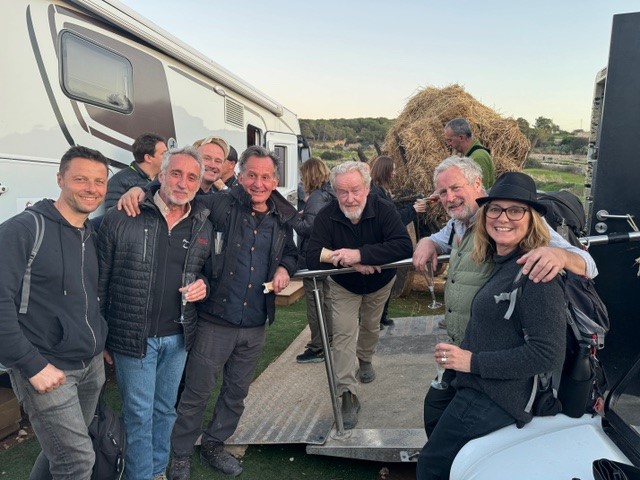
“When you’ve got lots of gaudy colours, fabrics, and textures it can become busy if you flat light it, so you separate out levels and chop it up,” he adds. “You don’t want to hide that lavishness, just to cut some shapes into the rooms. Sometimes I’d use a balloon to put a well of light over people or use Mole Beams or hard fresnel 18Ks to create some shape and add depth to the rooms.”
The work of the Academicism painters provided inspiration when illuminating spaces, from ‘The Death of Caesar’ by Jean-Léon Gérôme through to other Pre-Raphaelites Alma-Tadema. Goya, Velazquez, Georges de La Tour, Caravaggio, were powerful references when lighting night shots. “It might sound a bit pompous talking about paintings, but these painters had skill when creating depth and light. We don’t have the privilege on set of saying ‘You know what, I don’t like this. I’ll come back tomorrow,’ and I think by using other people’s film references, you’re still in that world. But if you look at a painting from 400 years ago, it’s interesting to consider what the artist was thinking. Why did they get it so right?” says Mathieson, who recommends cinematographers visit galleries.
“Don’t try to see everything – just look at six things and walk out of the gallery. It’s a nice thing to talk to Ridley and the art directors about too. There’s power in those images and you’re trying to siphon some of that off.”
Mathieson considers the grade an important part of the process. “As a cinematographer, you must grade your films. I came in, added notes, and didn’t really change too much, but I always manage to do my own grading. If you don’t, it’s like falling at the last fence,” he says.
The cinematographer was working days shooting the latest instalment in the Jurassic Park franchise before cycling to Company 3’s London location to remotely grade another gargantuan production, Gladiator II with senior colourist Stephen Nakamura working in his colour grading theatre in one of Company 3’s Los Angeles locations. “I met Stephen on Robin Hood and he has been with Ridley for years. He has an excellent eye. He got the vibe for the film early on,” says Mathieson.
Nakamura considers Mathieson “a pro’s pro” who has “shot so many films, styles and genres, so I always know I’m going to have a lot to work with”. When grading Mathieson’s work, “it’s never about ‘fixing’ things, it’s more like adding a fine polish,” says Nakamura. “That might mean building a Power Window around say Paul Mescal’s face to bring it up slightly or keying a fireplace and just bringing the flame down a little so they aren’t distracting. It’s always about directing the viewer’s eye to what’s most important. John knows exactly what I can do in post and is able to factor that into how he lights on set.”
Scott does not carry out a lot of experimentation in the grade as he “knows what he wants, so for some of the scenes that are meant to stand out as different from the rest, he asked me to bring the saturation way down (in contrast to most of the film which was rich in colour),” continues the colourist. “In some flashbacks of the main character as a boy, we made it almost black-and-white with just a touch of colour left. For some dream sequences, we pulled out all colour from the image and added a tint with a very cool colour temperature that makes everything feel ethereal.”
Mathieson views Ridley’s visual language as “very fast, like a music video director”. He elaborates: “He comes from advertising. Now if you can sell things to people they don’t need in 30 seconds, you’ve got a talent. And if you look at the beginning of Gladiator and some of his other films, there’s nothing typed, none of those things are written down. They’re frames form his storyboards, however the way they cut together, when and where he places them, that’s what makes his stories iconic.”
